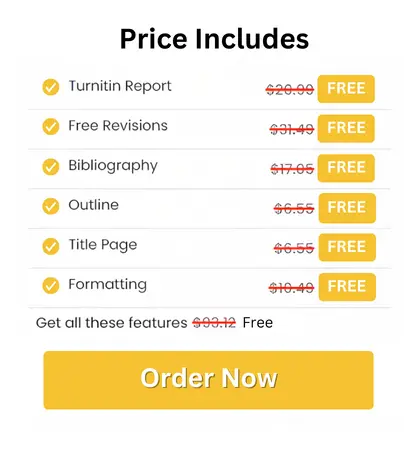
TCHR2003 Curriculum Studies in Early Childhood Education Report 1 Sample
Assignment Details
Assessment 1 invites you to step into the role of a curriculum architect for a new early childhood service, "Southern Cross Early Learning”. The task requires you to demonstrate your understanding of how to design a vibrant and engaging curriculum and learning environment for children aged birth to five, drawing on your understanding of play-based learning as described in the Early Years Learning Framework and the National Quality Standard. This task encourages you to critically analyse your curriculum choices, provide justification based on theoretical perspectives, and ensure that learning areas and experiences foster holistic child development. The importance of aligning theory, curriculum standards, and practical pedagogical decisions in early childhood education are emphasised.
Instructions
Use the template (including the cover page) provided in the Assessment 1 folder on the TCHR2003 Blackboard Site.
In this task, you are the curriculum architect for a brand-new early childhood centre: "Southern Cross Early Learning". You will unleash your creativity and expertise to develop a vibrant, engaging curriculum and design learning spaces that inspire curiosity, wonder, and development for children aged birth to five. This project allows you to step into the shoes of an early childhood educator, crafting unique learning areas while grounding your ideas in research and evidence-based practices.
Part 1.
Instructions: Write a 500-word document in full paragraphs (not dot points) for the service’s Educational Leader explaining your vision for the service’s curriculum.
Create a lively, persuasive piece that includes:
1. Curriculum definition: Describe what “curriculum” means in early childhood education
2. Curriculum vision. Explain how the service can incorporate play-based learning, and the approaches that can be used.
• Use an engaging scenario or anecdote to illustrate your point.
3. Justification: Share how a curriculum framework benefits children, educators, and families.
• Use relatable examples to show how the curriculum ensures every child thrives.
4. Links to the Early Years Learning Framework [EYLF] (AGDE, 2022), National Quality Standard [NQS] (ACECQA, 2018) theory and literature (as appropriate).
Part 2.
Use the templates to create 2 (two) different learning environments at “Southern Cross Early Learning” that could support thinking and learning: 1 (one) indoor environment and 1 (outdoor) environment.
Both of your 2 learning environments must integrate the following learning domains: Science, Numeracy/Maths, Technology. Each learning environment should be approximately 550 words (this does not include headings).
You are required to demonstrate how each environment supports integrated learning across multiple (maximum 3) developmental domains (physical/cognitive/language/social and emotional/creative) by:
• Describing the physical layout and resources you will include in the learning environment (e.g., furniture, materials, displays)
• Providing a rationale/justification for the learning environment. Explain how the elements included in the environment support the developmental domains. Make direct links to theory and relevant literature
• Analysing your learning environment. Reflect on the strengths and potential limitations. Discuss adaptations to ensure inclusivity for children with disabilities or developmental delays. Explain how you would make the environment culturally responsive (e.g., including artifacts or materials representing various cultures).
• Making 2 (two) connections to the EYLF v2.0
• Making 2 (two) connections to the NQS
• Providing examples of resources that can be found in the learning environment
• Images of the learning environment (these can either be images that you have taken yourself, or ones that you have sourced *these images do not need to be referenced)
Part 3
Referencing
• APA Referencing style is required to be used for this task
• Include one reference list for all responses on a new page at the end of task
• A minimum of 10 (ten) academic sources are to be included in the reference list
• At a minimum, your sources for this task will include the EYLF v2.0 (AGDE, 2022), NQS (ACECQA, 2018), and a range of broader authoritative literature. Broader literature may include contemporary textbooks, peer reviewed articles, and other authoritative sources.
Solution
Part 1
Vision for Southern Cross Learning’s Curriculum
1. A structured learning framework that can develop children’s learning experience can be identified as learning curriculum (Edwards, 2021). At Southern Cross, we see our curriculum as the improvement of cognitive skills and learning abilities of children. Additionally, learning curriculum is effective in improving social, emotional and physical development of children in their early ages. Intentional teaching is also associated with learning curriculum (McLachlan, Fleer & Edwards 2018). A planned framework to improve children’s learning abilities is a pivotal aspect our curriculum at Southern Cross.
2. According to Early Learning Framework by Australian Government Department of Education (AEGDE), the vision of the curriculum is aimed at love, becoming and belonging (AGDE, 2022). In addition, the vision is also focused on skills and knowledge development, improving communication abilities and developing emotional outcomes. Interacting with others by engaging in several activities is an important aspect of early childhood education curriculum (Boyd, Green & Jovanovic, 2021). Aiming at play-based for Deakin university assignment help learning is also an advantageous that comes under our education curriculum.
According to Piaget’s theory, play-based learning is associated with exploring a sense of real world while playing (Alharbi, 2022). Observing children’s behaviour in play activities and working on development needs is an important aspect of an educator’s role when considering education curriculum. In the case of Southern Cross Learning Curriculum, there is the strong presence of maintaining national standards set by the government. Developing excellence is an important aspect when considering national quality standards in the case of the vision of education curriculum (ACECQA, 2018). However, the strong vision of the curriculum is helpful for children to enhance independence, confidence and curiosity.
3. Aiming at a structured and planned curriculum, children are advantageous in shaping various skills like communication, cognitive abilities and problem-solving approaches (Blewitt et al., 2020). In addition, children’s emotional outcomes are also developed with the help of an enhanced education curriculum. Ownership-building skills are also significant for children when considering the advantages of education curriculum. For instance, gardening session is appropriate for children to be responsible of watering and taking care of plants. Besides the mentioned, the advantage of curriculum is also appropriate to focus on intentional teaching. Additionally, this has been aimed at developing unique skills of children. Besides this, learning curriculum is also advantageous for children to deal with their identity creation and cultural belonging perspectives with the help of play-based learning. In this manner, children are leverage of Southern Cross Education Curriculum.
4. In the case of Southern Cross Learning Curriculum, there is the presence of respectful relationship and learning through play, which are entitled in Early Years Learning Framework (AGDE, 2022). Educators are taking care of children and monitoring the activities and development of each child. On the other hand, National Quality Standards are associated with providing children health and safety and making effective relationships with children (ACECQA, 2018). At Southern Cross, the educational curriculum is set to provide all safety to the children alongside interacting with each child by being supportive to develop good relationship.
Part 2 Indoor
Description:
In the case of indoor learning environment, dealing with creativity and hands-on learning is an important consideration. In addition, the learning framework used in the indoor learning environment is subjected to enhance the problem-solving abilities of children (Brink et al., 2021). Building blocks can be considered as an example of indoor learning environment by which numerical understanding can be fostered for children. Indoor learning environment is also effective in enhancing understanding abilities of learners (Brink et al., 2021). For instance, displaying some digital storytelling activities can enhance the comprehension of various aspects when considering indoor learning environment. In additional, computational thinking can be developed in this regard.
Rationale/Justification (with direct links to theory and literature):
Aiming at holistic learning environment is an important consideration when undertaking the relevance of indoor learning environment (Taylor & Boyer, 2020). However, considering some educational theories can be undertaken in the case of linking theories to indoor learning environment. For instance, Vygotsky’s sociocultural theory suggests that social interactions can lead to effective cognitive development of learners (Huang, 2021). In the case of building blocks as an indoor learning activity, it can be stated that social interactions with peers can be advantageous for learners to deal with collaboration and connection with others. This can enhance child’s emotional and cognitive abilities. However, aiming at cultural values is also associated with the indoor activity when considering sociocultural contexts. Children from different cultures are engaged in a single activity by which respective others are undertaken by the children, which is aimed social development of children. On the other hand, Piaget’s constructivist theory is subjected to deal with hands-on experience (Peters & D’Penna, 2020). For example, setting puzzles is an activity where children are engaged in setting puzzles to create a formation or word puzzles to make a word. This can enhance the problem-solving abilities of children.
Analysis
Structured learning and open-ended exploration can be included in the case of dealing with indoor learning environment. In addition, undertaking sensory materials is also effective for indoor learning environment (Taylor & Boyer, 2020). However, indoor learning environment is providing a positive impact on developing diverse skills of children like problem-solving, communication and creativity. For instance, the wooden puzzle activity is associated with cognitive and physical development of children in the case of indoor learning environment. Contrastingly, indoor learning environment materials sometimes not much suitable for sensory sensitives. According to AGDE (2022), all children need to be valued and being responsible to all cultural backgrounds children need to be respected. Hence, it is needed to avoid uncertainties in accessing learning materials for sensory sensitivity children.
EYLF Links:
Learning Outcome 1: A strong sense of identity needs to be for all children (AGDE, 2022).
Inclusive indoor environment needs to be represented for all children to provide values and feeling safe to enhance confidence and foster their engagement in learning environment.
Learning Outcome 4: Children should be confident and they need to be involved in the learning environment (AGDE, 2022).
In this regard, the indoor learning environment needs to be collaborative so that different skills like problem-solving and communication can be developed.
NQS Links:
QA3 (3.2.1) Inclusive Environment (ACECQA, 2018)
Inclusive learning needs to be represented for all the children to aim at diverse learning needs even for sensory sensitivities.
QA5 (5.2.1): Learning opportunities need to be collaborative (ACECQA, 2018)
Interactive learning support should be for indoor environment by which social interactions and team working abilities can be developed.
Resources:
Digital devices (tablets)
Digital Storytelling
Wooden blocks
Part 2: Outdoor environment
Description:
Focusing on social and physical development is an important aspect for outdoor learning environment (Taylor & Boyer, 2020). In addition, fostering imaginative exploration is also included in the outdoor learning environment. For instance, consider sand activity as an outdoor environment. Now, using buckets, shovels and seeking help from peers are some of the features that can develop problem-solving skills and collaborative skills of children. On the other hand, outdoor learning environment is also effective for experiencing new things by which knowledge-development phenomenon can be aimed (Fleer, 2021). For example, water play activity is associated with pipes, funnels and containers. In this regard, children can have experience in idealising the volumes and cause-effect relationships by which their knowledge can be developed. However, social interaction abilities are developed with the help of outdoor learning environment (Cheng et al., 2023). For instance, art and creativity session can be advantageous for children to deal with chalks and easels, which are helpful for them to expressing their ideas by painting, drawing and storytelling. In this manner, they can portray their thoughts and feelings to others, which is effective for sharing knowledge to others as a social interaction outcome.
Rationale/Justification (with direct links to theory and literature):
Sociocultural theory by Vygotsky is aimed at social interactions as a learning method (Huang, 2021). For example, in the case of sand activity, children are associated with a team work and use shovels and sands to create a structure. This is effective in encouraging children in collaborating with others. Sharing own ideas and dealing with problems can be possible with the help of sand activity, which is a result of social interaction. Contrarily, Piaget’s constructivist theory is associated with hands-on learning experience of learning (Halid, 2024). In the case of the water play activity, measuring water can directly enhance children’s knowledge regarding measurement and displacement.
Analysis
The discussed examples of outdoor environment are associated with socio-emotional development and physical improvement of children. However, all the activities are effective in interacting with others, which is associated with strengthening collaborative skills of children. In addition, communication skills are also a positive impact of the outdoor learning environment that discussed before.
EYLF Links:
Learning Outcome 1: The strong sense of identity is needed to be developed for children (AGDE, 2022).
Participation in all the activities is an important aspect of the outdoor activities by which children’s confidence can be developed in a team work environment. This has also improved a strong sense of belonging.
Learning Outcome 5: A range of media can be helpful for expressing ideas of children (AGDE, 2022).
Art and creativity session is advantageous for children to use the artistic visualisation as a source of media, which can develop the communication and interactions abilities of children. In addition, literacy and creative can be also improved in this regard, through the art and creativity session.
NQS Links:
QA3. Physical environment needs to be in favour of children (ACECQA, 2018).
In the case of art and creativity session or sand activity, an attractive environment can be advantageous to encourage children to engage in the learning environment.
QA6. Making collaborations with families and communities (ACECQA, 2018).
Inviting friends and family members within the sand activity can be effective to enhance cultural awareness.
Resources:
Sand activity
Water play session
Part 3
ACECQA. (2018). National Quality Standard. Retrieved March 29, 2025, from https://www.acecqa.gov.au/nqf/national-quality-standard
AGDE. (2022). Belonging, Being and Becoming: The Early Years Learning Framework for Australia (V2.0). Australian Government Department of Education for the Ministerial Council. Retrieved March 29, 2025, from https://www.acecqa.gov.au/sites/default/files/2023-01/EYLF-2022-V2.0.pdf
Alharbi, M. O. (2022). Teachers and children’s play: Exploring practices through an analysis of Vygotsky and Piaget theories. The Educational Review, USA, 6(11). DOI: 10.26855/er.2022.11.001
Blewitt, C., O’connor, A., Morris, H., Mousa, A., Bergmeier, H., Nolan, A., ... & Skouteris, H. (2020). Do curriculum-based social and emotional learning programs in early childhood education and care strengthen teacher outcomes? A systematic literature review. International journal of environmental research and public health, 17(3), 1049. doi:10.3390/ijerph17031049
Boyd, W., Green, N., & Jovanovic, J. (2021). Learning and teaching in early childhood: Pedagogies of inquiry and relationships. Cambridge University Press.
Brink, H. W., Loomans, M. G., Mobach, M. P., & Kort, H. S. (2021). Classrooms' indoor environmental conditions affecting the academic achievement of students and teachers in higher education: A systematic literature review. Indoor air, 31(2), 405-425. DOI: 10.1111/ina.12745
Cheng, T., Brussoni, M., Han, C., Munday, F., & Zeni, M. (2023). Perceived challenges of early childhood educators in promoting unstructured outdoor play: an ecological systems perspective. Early Years, 43(4-5), 904-920. https://doi.org/10.1080/09575146.2022.2034140
Edwards, S. (2021). Process quality, curriculum and pedagogy in early childhood education and care. OECD education working papers, (247), 0_1-55. https://dx.doi.org/10.1787/eba0711e-en
Fleer, M. (2021). Play in the early years. Cambridge University Press. https://www.academia.edu/download/88745396/9781107032293_frontmatter.pdf
Halid, L. I. (2024). Constructivist Approach to Language Learning: Linking Piaget's Theory to Modern Educational Practice. INTERACTION: Jurnal Pendidikan Bahasa, 11(2), 306-327. https://e-journal.unimudasorong.ac.id/index.php/interactionjournal/article/download/33/12
Huang, Y. C. (2021, May). Comparison and contrast of Piaget and Vygotsky’s Theories. In 7th International Conference on Humanities and Social Science Research (ICHSSR 2021) (pp. 28-32). Atlantis Press. https://www.atlantis-press.com/article/125956903.pdf
McLachlan, C., Fleer, M., & Edwards, S. (2018). Early childhood curriculum: Planning, assessment and implementation. Cambridge University Press. https://books.google.com/books?hl=en&lr=&id=krpQDwAAQBAJ&oi=fnd&pg=PR8&dq=McLachlan,+C.,+Fleer,+M.,+%26+Edwards,+S.+(2018).+Early+Childhood+Curriculum:+Planning,+Assessment,+and+Implementation+(2nd+ed.).+Cambridge+University+Press.&ots=cdK7UMIk2Q&sig=4h_75hPIV-kBCIcDMUV_kxxe8M4
Peters, T., & D’Penna, K. (2020). Biophilic design for restorative university learning environments: A critical review of literature and design recommendations. Sustainability, 12(17), 7064. https://doi.org/10.3390/su12177064
Taylor, M. E., & Boyer, W. (2020). Play-based learning: Evidence-based research to improve children’s learning experiences in the kindergarten classroom. Early Childhood Education Journal, 48(2), 127-133. https://dspace.library.uvic.ca/bitstreams/35af1d3d-38a0-418a-a4db-73013f194a58/download



 81 Isla Avenue Glenroy, Mel, VIC, 3046 AU
81 Isla Avenue Glenroy, Mel, VIC, 3046 AU



